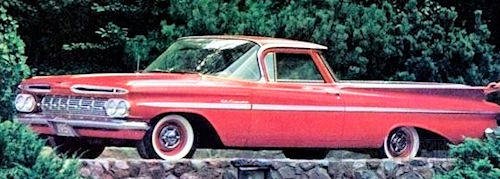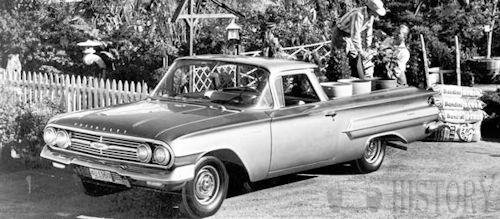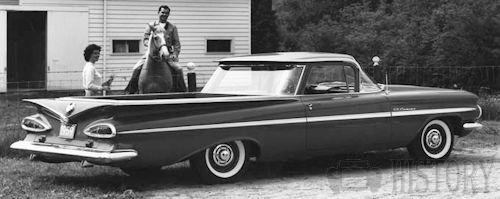Chevrolet El Camino First generation
| 1959 to 1960 | |
|---|---|
 | |
| Overview | |
| Production | 1958–1960 |
| Model years | 1959–1960 |
| Assembly | Arlington, Texas, United States |
| Body and chassis | |
| Related | Chevrolet Biscayne Chevrolet Bel Air |
| Powertrain | |
| Engine | 235 cu in (3.9 L) I6 283 cu in (4.6 L) V8 348 cu in (5.7 L) V8 |
| Transmission | 3-speed manual 4-speed manual 2-speed Powerglide automatic |
| Dimensions | |
| Wheelbase | 119" |
| Length | 210.9" |
History
Ford Australia was the first company to produce a coupe utility as a result of a 1932 letter from the wife of a farmer in Victoria, Australia asking for “a vehicle to go to church in on a Sunday and which can carry our pigs to market on Mondays Ford designer Lew Bandt developed a suitable solution, and the first coupe utility model was released in 1934. Bandt went on to manage Ford’s Advanced Design Department, being responsible for the body engineering of the XP, XT, XW, and XA series Ford Falcon utilities. General Motors’ Australian subsidiary Holden also produced a Chevrolet coupe utility in 1935, Studebaker produced the Coupe Express from 1937 to 1939, but the body style did not reappear on the American market until the release of the 1957 Ford Ranchero.
Both the coupe utility and the similar open-topped roadster utility continued in production, but the improving economy of the mid- to late-1930s and the desire for improved comfort saw coupe utility sales climb at the expense of the roadster utility until, by 1939, the latter was all but a fading memory.
The mid-1955 introduction of Chevrolet's Cameo Carrier pickup truck helped pave the way for the El Camino. Although it was a model variant of Chevrolet's light-duty pickup, the Cameo offered an array of car-like features that included passenger-car styling, fiberglass rear fenders, two-tone paint, a relatively luxurious interior, as well as an optional V8 engine, automatic transmission, and power assists. Other pickup truck producers, including Dodge, Ford, and International, began to offer flush-side cargo boxes on some of their 1957 models. However, Ford also introduced the 1957 Ranchero, and established a new market segment in the U.S. market of an automobile platform based coupe utility. In 1959, Chevrolet responded with the El Camino to compete with Ford's full-sized Ranchero. The original El Camino and Ranchero would compete directly only in the 1959 model year.
The El Camino was introduced for the 1959 model year two years after the Ford Ranchero. According to Chevrolet stylist Chuck Jordan, GM Harley Earl had suggested a coupe pickup in 1952.
Like the Ranchero, it was based on an existing and modified platform, the new-for-1959 Brookwood two-door station wagon, itself based on the completely redesigned, longer, lower and wider full-sized Chevrolet. Highly stylized, it initially sold 50% more briskly than the more conservative Ranchero, some 22,000 to 14,000.
Unlike the Brookwoods wagon and a sedan delivery variant, the El Camino was available any full-sized Chevy drivetrain. It came in a single trim level, its exterior using the Bel-Air's and interior of a low-end Biscayne. Its chassis featured Chevrolet's "Safety-Girder" X-frame design and a full-coil suspension, both introduced in the 1958 model year. The 119-inch (3,000 mm) wheel-base was 1.5 inches (38 mm) longer, and overall length for all 1959 Chevys was up to 210.9 inches (5,360 mm). The El Camino's payload rating ranged from 650 to 1150 pounds, with gross vehicle weights ranging from 4400 to 4900 pounds depending on powertrain and suspension. The somewhat soft passenger car suspension of the base model left the vehicle level without a load, in contrast the Ranchero, where standard 1100-pound rated heavy duty rear springs gave it a distinct rake when empty. The quirky Level Air suspension option, in its second and final year, was listed as available, but was almost never seen on any Chevrolet model, much less an El Camino. The 1959 El Camino was promoted as the first Chevrolet pickup built with a steel bed floor instead of wood. The floor was a corrugated sheetmetal insert, secured with 26 recessed bolts. Concealed beneath it was the floor pan from the Brookwood two-door wagon, complete with foot wells. Box capacity was almost 33 cubic feet (0.93 m3).
Among the performance engines offered were a 283-cid Turbo-jet V8 with two- or four-barrel carburetion, several Turbo-Thrust 348-cid V8s with four-barrel or triple two-barrel carbuerators producing 335 bhp (250 kW; 340 PS), and 250- and 290-bhp 283-cube Ramjet Fuel Injection V8s.
Hot Rod magazine conducted a test of an El Camino equipped with the hottest powertrain combination available in early 1959—a 315 bhp (235 kW; 319 PS), triple-carb, solid-lifter 348 V8 mated to a four-speed. Staff testers clocked 0-60 mph times of around seven seconds, estimated top speed at 130 mph (210 km/h), and predicted 14-second/100-mph quarter-mile performance with a rear-axle ratio suitable for drag racing installed.
A total of 22,246 El Caminos were produced for 1959. That bested the count of 21,706 first-year Rancheros made in 1957 and the 14,169 Ford sedan pickups built in direct competition for the 1959 model year. But 1960 would be a different story.

1960 Chevrolet El Camino First generation
The similar but less flamboyant 1960 model started at $2366 for the six-cylinder model; another $107 for a V8 with the two-barrel 283. At first glance, the exterior once again had a Bel Air look, with that series' bright-metal "jet" appliqué and narrow trailing molding used to accent the rear quarters. Inside, Biscayne/Brookwood appointments also persisted. The seat was now covered in striped-pattern cloth with vinyl facings. Available interior trim shades were once again gray, blue, and green. Floor coverings were in medium-tone vinyl. Mid-1959 powertrain availability was carried over with minimal changes for 1960: The base 283-cid V8 was detuned a bit for fuel economy and was now rated at 170 bhp (127 kW; 172 PS), and the fuel-injected engines were officially gone.
Orders plummeted by a third, to just 14,163, at which point Chevrolet discontinued the model; meanwhile, Ford moved 21,027 Rancheros, which were now based on the brand-new Falcon compact. The pioneering American sedan pickups just did not connect with enough car-buying Americans. Perhaps these early "crossovers" didn't carry enough passengers; in a time when baby-boomer families dominated the market, three across was the best they could offer. The low-level trim and marketing efforts focused almost exclusively on commercial customers may have inhibited sales, as well.
1959 Chevrolet El Camino First generation rear





